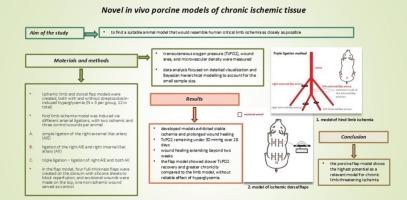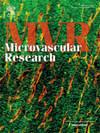猪慢性缺血组织的新型体内模型。
IF 2.7
4区 医学
Q2 PERIPHERAL VASCULAR DISEASE
引用次数: 0
摘要
目前缺乏可靠的体内模型来复制人体肢体缺血。为了填补这一空白,我们开发并验证了两种新的猪缺血模型:缺血肢体和背瓣模型,包括和不包括链脲佐菌素诱导的高血糖(N = 每组3,共12)。采用不同的动脉结扎法建立后肢缺血模型,每只动物2个缺血创口和3个对照创口。在皮瓣模型中,在背侧制作4个全厚皮瓣,用硅胶片阻断再灌注,并在顶部做切除创面。1个非缺血性创面作为对照。测量经皮氧压(TcPO2)、创面面积和微血管密度,纵向评估TcPO2和创面面积。数据分析侧重于详细的可视化和贝叶斯分层建模,以解释小样本量。开发的模型表现出稳定的缺血和延长的伤口愈合,在28 天内TcPO2保持在30 mmHg以下,伤口愈合持续超过两周。与肢体模型相比,皮瓣模型的TcPO2恢复较慢,慢性性更强,无可靠的高血糖效果。因此,猪皮瓣模型作为慢性肢体缺血的相关模型显示出最高的潜力。本文章由计算机程序翻译,如有差异,请以英文原文为准。

Novel in vivo porcine models of chronic ischemic tissue
There is a lack of reliable in vivo models that replicate limb-threatening ischemia in humans. To fill this gap, we developed and validated two novel porcine ischemic models: ischemic limb and dorsal flap models, both with and without streptozotocin-induced hyperglycemia (N = 3 per group, 12 in total). Hind limb ischemia model was induced via different arterial ligations, with two ischemic and three control wounds per animal. In the flap model, four full-thickness flaps were created on the dorsum with silicone sheets to block reperfusion, and excisional wounds were made on the top. One non-ischemic wound served as control. Transcutaneous oxygen pressure (TcPO2), wound area, and microvascular density were measured, with TcPO2 and wound area assessed longitudinally. Data analysis focused on detailed visualization and Bayesian hierarchical modelling to account for the small sample size. Developed models exhibited stable ischemia and prolonged wound healing, with TcPO2 remaining under 30 mmHg over 28 days, and wound healing extending beyond two weeks. The flap model showed slower TcPO2 recovery and greater chronicity compared to the limb model, without reliable effect of hyperglycemia. Thus, the porcine flap model shows the highest potential as a relevant model for chronic limb-threatening ischemia.
求助全文
通过发布文献求助,成功后即可免费获取论文全文。
去求助
来源期刊

Microvascular research
医学-外周血管病
CiteScore
6.00
自引率
3.20%
发文量
158
审稿时长
43 days
期刊介绍:
Microvascular Research is dedicated to the dissemination of fundamental information related to the microvascular field. Full-length articles presenting the results of original research and brief communications are featured.
Research Areas include:
• Angiogenesis
• Biochemistry
• Bioengineering
• Biomathematics
• Biophysics
• Cancer
• Circulatory homeostasis
• Comparative physiology
• Drug delivery
• Neuropharmacology
• Microvascular pathology
• Rheology
• Tissue Engineering.
 求助内容:
求助内容: 应助结果提醒方式:
应助结果提醒方式:


